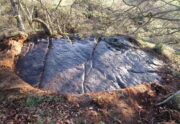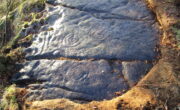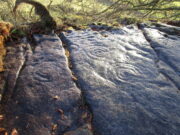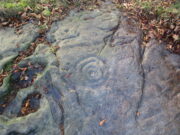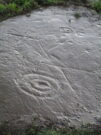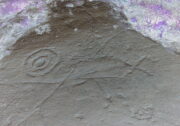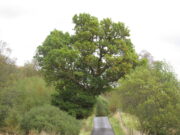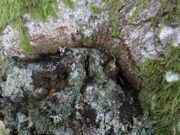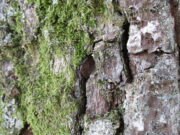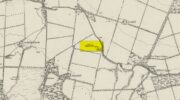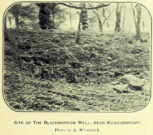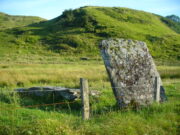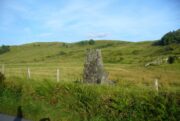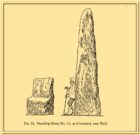Cup-and-Ring Stone: OS Grid Reference – NN 67511 25028
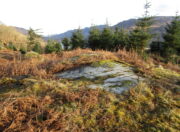
On the A85 road from St Fillans to Lochearnhead, about 1½ miles on is the Loch Earn Sailing Club, with a large parking spot thereby. From here, cross the road and go through the gate up the dirt-track, past the cottages where the track bends right until a few hundred yards further up where the track splits, bear right, along and down across the river, up the other side and past the cottage. From here, the track becomes a grassy footpath. Walk along here, east towards the trees 5-600 yards away. Once you go through the large wooden slip-gate, about 150 yards on the path into the scattered trees, you’ll see a large dome-shaped rise on your right (south). Y’ can’t really miss it!
Archaeology & History
This carving was rediscovered by the great Scottish petroglyph writer Ron Morris in 1968. He told that, just below the overgrown track, “is a big dome-shaped outcrop with a smooth top. On a scattered area on this, in 3 main groups, are over 24 cup-marks, up to 3″ diameter, ½” deep.” But these aren’t mere cup-marks…
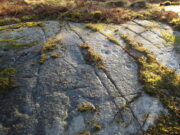
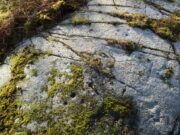
It literally is just like a large dome of rock, with carvings on certain sections of it. Half of the cup-marks are easy to see, especially the ones near to the top of the dome and which exist in three main clusters. Much more faint is another, larger cluster of cups, on its south-side.
Dealing with those on top of the rock: on the easternmost side a long natural crack separates a faint single cup-mark from a notable triangle of three, clearly visible in the photo (left). Below this are what may be a couple more cups, but they were difficult to make out and may simply be Nature’s handiwork. Certainly Nature has a part to play in the next small cluster of cups about six-feet further along the stone. A shallow natural ‘arc’ has clearly been used to create a ring around one of the cups, clearly visible in the photo (right), with another faint cup-and-ring visible below it. In between these, both Paul Hornby and I could make out what may be another incredibly faint smaller cup-and-ring (and which seemed evident on a couple of photos), but we need to wait for the computer-tech boys to get their teeth into that one! Several other single cup-marks exist either side of another moss-covered crack in the rock. And as we roll over the top western-edge of the stone, another small cluster of three, maybe four single cup-marks greets our attention.
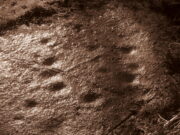
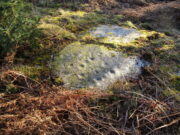
It’s on the sloping south-side of the stone where the best cluster is found. At least ten faint cup-marks—one or two with very faint incomplete rings round them—are arranged in gentle arcs into the rock. On both sides of this section is a covering of vegetation, beneath which the carved designs probably continue. In fact if this entire stone dome was completely free of vegetation, it’s likely we’d have a much larger piece of prehistoric rock art. A job for future antiquarians perhaps…
References:
- Morris, Ronald W.B., “Glentarken Wood, Strathyre – Cup-marked Rocks,” in Discovery & Excavation Scotland, 1969.
Acknowledgments: Big thanks to Paul Hornby for use of his photographs. Cheers dood. 😉
© Paul Bennett, The Northern Antiquarian
